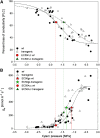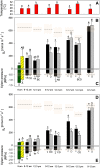Down-regulation of plasma intrinsic protein1 aquaporin in poplar trees is detrimental to recovery from embolism
- PMID: 24572173
- PMCID: PMC3982741
- DOI: 10.1104/pp.114.237511
Down-regulation of plasma intrinsic protein1 aquaporin in poplar trees is detrimental to recovery from embolism
Abstract
During their lifecycles, trees encounter multiple events of water stress that often result in embolism formation and temporal decreases in xylem transport capacity. The restoration of xylem transport capacity requires changes in cell metabolic activity and gene expression. Specifically, in poplar (Populus spp.), the formation of xylem embolisms leads to a clear up-regulation of plasma membrane protein1 (PIP1) aquaporin genes. To determine their role in poplar response to water stress, transgenic Populus tremula × Populus alba plants characterized by the strong down-regulation of multiple isoforms belonging to the PIP1 subfamily were used. Transgenic lines showed that they are more vulnerable to embolism, with 50% percent loss of conductance occurring 0.3 MPa earlier than in wild-type plants, and that they also have a reduced capacity to restore xylem conductance during recovery. Transgenic plants also show symptoms of a reduced capacity to control percent loss of conductance through stomatal conductance in response to drought, because they have a much narrower vulnerability safety margin. Finally, a delay in stomatal conductance recovery during the period of stress relief was observed. The presented results suggest that PIP1 genes are involved in the maintenance of xylem transport system capacity, in the promotion of recovery from stress, and in contribution to a plant's control of stomatal conductance under water stress.
Figures








Similar articles
-
Responses to Drought Stress in Poplar: What Do We Know and What Can We Learn?Life (Basel). 2023 Feb 15;13(2):533. doi: 10.3390/life13020533. Life (Basel). 2023. PMID: 36836891 Free PMC article. Review.
-
Patterns of PIP gene expression in Populus trichocarpa during recovery from xylem embolism suggest a major role for the PIP1 aquaporin subfamily as moderators of refilling process.Plant Cell Environ. 2010 Aug 1;33(8):1285-97. doi: 10.1111/j.1365-3040.2010.02147.x. Epub 2010 Mar 18. Plant Cell Environ. 2010. PMID: 20302602
-
Variation in embolism occurrence and repair along the stem in drought-stressed and re-watered seedlings of a poplar clone.Physiol Plant. 2013 Mar;147(3):329-39. doi: 10.1111/j.1399-3054.2012.01665.x. Epub 2012 Jul 14. Physiol Plant. 2013. PMID: 22686493
-
Stomatal factors and vulnerability of stem xylem to cavitation in poplars.Physiol Plant. 2011 Oct;143(2):154-65. doi: 10.1111/j.1399-3054.2011.01489.x. Epub 2011 Jun 28. Physiol Plant. 2011. PMID: 21623799
-
The functional role of xylem parenchyma cells and aquaporins during recovery from severe water stress.Plant Cell Environ. 2017 Jun;40(6):858-871. doi: 10.1111/pce.12831. Epub 2016 Oct 26. Plant Cell Environ. 2017. PMID: 27628165 Review.
Cited by
-
Responses to Drought Stress in Poplar: What Do We Know and What Can We Learn?Life (Basel). 2023 Feb 15;13(2):533. doi: 10.3390/life13020533. Life (Basel). 2023. PMID: 36836891 Free PMC article. Review.
-
Physiological and genomic basis of mechanical-functional trade-off in plant vasculature.Front Plant Sci. 2014 May 28;5:224. doi: 10.3389/fpls.2014.00224. eCollection 2014. Front Plant Sci. 2014. PMID: 24904619 Free PMC article. Review.
-
Genome-Wide Identification and Characterization of Aquaporins and Their Role in the Flower Opening Processes in Carnation (Dianthus caryophyllus).Molecules. 2018 Jul 29;23(8):1895. doi: 10.3390/molecules23081895. Molecules. 2018. PMID: 30060619 Free PMC article.
-
The role of plasma membrane aquaporins in regulating the bundle sheath-mesophyll continuum and leaf hydraulics.Plant Physiol. 2014 Nov;166(3):1609-20. doi: 10.1104/pp.114.248633. Epub 2014 Sep 29. Plant Physiol. 2014. PMID: 25266632 Free PMC article.
-
Physiological and PIP Transcriptional Responses to Progressive Soil Water Deficit in Three Mulberry Cultivars.Front Plant Sci. 2020 Aug 28;11:1310. doi: 10.3389/fpls.2020.01310. eCollection 2020. Front Plant Sci. 2020. PMID: 32983200 Free PMC article.
References
-
- Brennen CE. (1995) Cavitation and Bubble Dynamics, Vol 44 Oxford University Press, Inc., Oxford, United Kingdom
Publication types
MeSH terms
Substances
LinkOut - more resources
Full Text Sources
Other Literature Sources
Miscellaneous

